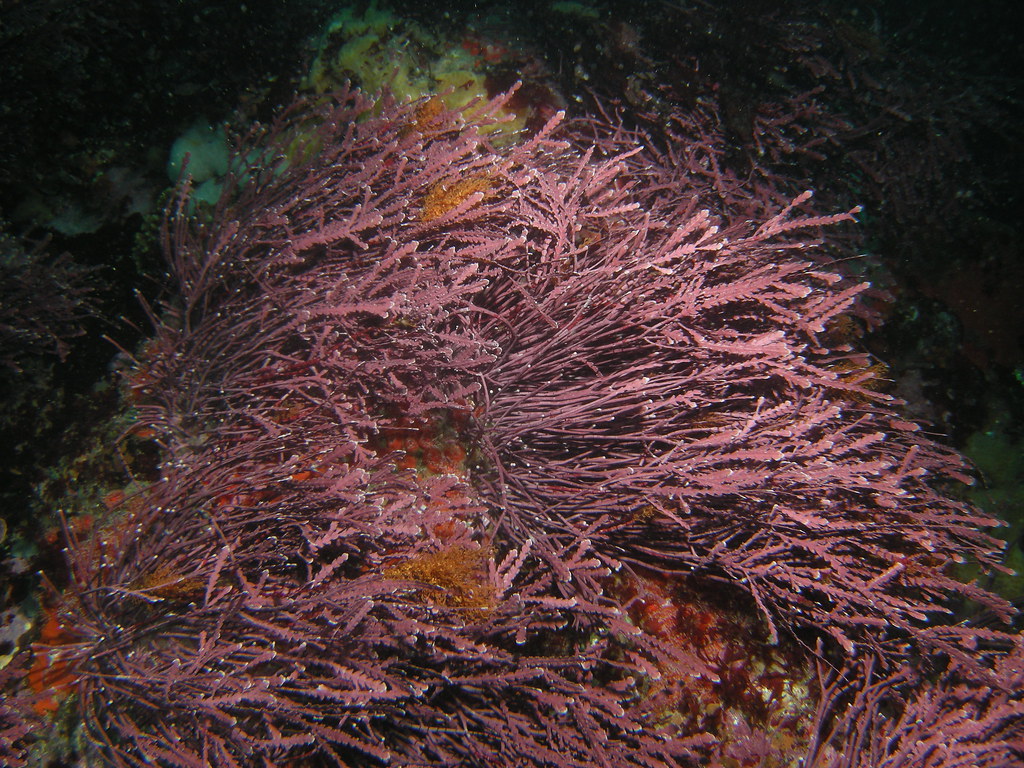 "Rhodophyta (Red algae)" by Ed Bierman is licensed under CC BY 2.0
"Rhodophyta (Red algae)" by Ed Bierman is licensed under CC BY 2.0
Definition of Rhodophyta (Red Algae)
The term "Rhodophyta" comes from the Greek, rhodos which means "red". So, Rhodophyta means red algae ( red algae ). Unlike other phyla, this phylum does not have flagella stages in its life cycle. Members of this phylum have photosynthetic pigments in the form of phycobilins consisting of phycoerythrin (red pigment) and phycocyanin (blue pigment). In addition to these two pigments, Rhodophyta also has chlorophyll a and b and carotenoids.
Phycoerythrin is the most dominant pigment that causes the color of the thallus of this algae to turn red. However, not all of these algae are red. In the deep sea, this algae has a purple almost black color. At medium depths it is bright red, while at very shallow water, it is slightly greenish.
When this has been known for about 2,500 species, mostly live in the sea, especially the tropics and often called kelp ( sea weed ) because of her body shape like grass. Rhodophyta grows on rocks in tidal areas to depths of up to 90 meters below sea level where certain light waves from sunlight are still able to reach them.
Rhodophyta thallus is relatively large, but rarely exceeds 90 cm in length. Some species are filamentous, but most form complex structures that branch like feathers or are flattened and spread like ribbons. Generally, Rhodophyta are multicellular, but there are also unicellular Rhodophytes. Multicellular red algae are generally macroscopic and their body structure resembles a plant ( thallus ). Thallus in Rhodophyta in the form of strands or like plants.
Characteristics of Rhodophyta (Red Algae)
Red algae (Rhodophyta) have general characteristics or characteristics, including the following.
■ Core are eukaryotic cells because the cell nucleus already had membranes.
■ Most multicellular (multicellular).
■ Generally, macroscopic (visible with the naked eye) with a length of 1 m.
■ The only algae that do not have flagella phase in its life cycle.
■ Characteristically autotorof, because chlorophyll to perform photosynthesis.
■ The chloroplasts contain pirenoid to store the results of photosynthesis.
■ Backup food is stored in the form of flour fluoride (a type of carbohydrate), floridosid (compounds of glycerine and galactose) and drops of oil. Floridoside will have a reddish color when added with iodine.
■ The shape of the talus in the form of a strand or shaped like a tree.
The thallus is red to purple in color but some are blonde or reddish.
■ His body was covered with calcium carbonate (CaCO 3 ).
■ The cell walls consist of layered components. The inner cell wall is composed of myofibrils, while the outer cell is composed of mucus.
■ Have pigment chlorophyll a and b, carotenoids, phycocyanin (blue) and the dominant pigment fikoeritrin (red).
How to Reproduction Rhodophyta (Red Algae)
Red algae can reproduce asexually (vegetatively) and sexually (generatively). Asexual reproduction by forming aplanospores , namely nonmotile spores (not moving) and derived from diploid algae thallus. Furthermore, these spores will grow into new red algae. In Rhodophyta, fragmentation asexual reproduction is rare.
Sexual reproduction (generative) occurs by oogamy , and in some species undergo alternation of offspring (metagenesis). Sexual reproduction is carried out by the fusion of male gametes that have no locomotion (sperm) and ova. The male gametes are formed in the spermatangium, while the female gametes are formed in the carpogonium. The next fertilized zygote will grow into a diploid red algae.
The following is a life cycle chart or alternation of offspring in an example of a red algae species, Polysiphonia.
Based on the picture above, try to write down the sequence of asexual (vegetative) reproduction starting from the sporophyte. Then, also write down the sequence of sexual reproduction (generative) to the sporophyte!
The sporophyte produces meiospores which will develop into gametophytes. The gametophyte forms spermatangia which produce spermatia and carpogonium which contains trichogen cells . The spermatia attach to the tip of the trichogen, continuing to enter the base of the cell. Here the fusion occurs between the nucleus of the sperm and the nucleus of the female cell to form a zygote (goninoblast). Goninoblast is a filament that is formed from the zygote and at the end of the filament a carposporangium is formed .
Furthermore, in the carposporangium formed carpospora. Carpospora out of the carposporangium, to further grow into a sporophyte (new Polysphonia). In its growth, Polysiphonia undergo alternation of offspring (metagenesis), namely asexual reproduction and sexual reproduction take place alternately.
Examples and Roles of Rhodophyta (Red Algae) in Life
Some red algae serve as important supports for tropical coral reefs. Red algae is an important food ingredient in Asian countries. In Japan, for example, red algae are dried and used in a number of dishes. In addition to producing algin, red algae also produce carrageenan and agar.
Carrageenan ( carrageenan ) is a type of polysaccharide used as an ingredient in cosmetics and gelatin capsules and is an additive that can be added to puddings and ice cream. To be used as food. Apart from being used as a food ingredient, agar-agar is also used as a medium for microorganism culture, cosmetics, medicine, canned meat coating, ice cream hardener, as well as fat emulsifier and chocolate bars.
Some examples of Rodophyta are as follows.
■ Eucheuma spinosum , widely cultivated because it produces so many are in Indonesian waters.
■ Chondrus crispus , also cultivated known as seaweed.
■ Gelidium coulteri and Gracilaria sp. , as an ingredient for making gelatin, is widely available in cold waters of the country.
■ Carolina sp. is a member of Rhodophyta (red algae) whose body is coated by calcium carbonate.
■ Dasya, Batracnospermum, Scinaiafurcellata, Porphyra perforated , Polysphonia, Halosaccion glandiforme , Bossea orbigniana , and so on.
